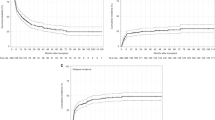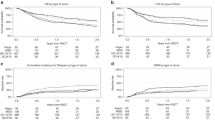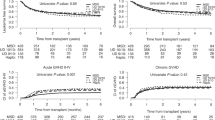Abstract
Although allogeneic hematopoietic cell transplantation (HCT) from a related donor is effective therapy for younger patients with AML, it remains unknown how the availability of a related donor affects the outcome when unrelated HCT is a treatment option for patients without a related donor. To address this issue, we retrospectively analyzed 605 cytogenetically non-favorable AML patients younger than 50 years for whom a related donor search was performed during first CR (CR1). The 4-year OS was 62% in 253 patients with a related donor and 59% in 352 patients without a related donor (P=0.534). Allogeneic HCT was performed during CR1 in 62% and 41% of patients with and without a related donor, respectively. Among patients transplanted in CR1, the cumulative incidence of non-relapse mortality was significantly higher in patients without a related donor (P=0.022), but there was no difference in post-transplant OS between the groups (P=0.262). These findings show the usefulness of unrelated HCT in younger patients with cytogenetically non-favorable AML who do not have a related donor. The extensive use of unrelated HCT for such patients may minimize the potential disadvantage of lacking a related donor.
This is a preview of subscription content, access via your institution
Access options
Subscribe to this journal
Receive 12 print issues and online access
$259.00 per year
only $21.58 per issue
Buy this article
- Purchase on Springer Link
- Instant access to full article PDF
Prices may be subject to local taxes which are calculated during checkout




Similar content being viewed by others
References
Gupta V, Tallman MS, Weisdorf DJ . Allogeneic hematopoietic cell transplantation for adults with acute myeloid leukemia: myths, controversies, and unknowns. Blood 2011; 117: 2307–2318.
Reiffers J, Stoppa AM, Attal M, Michallet M, Marit G, Blaise D et al. Allogeneic vs autologous stem cell transplantation vs chemotherapy in patients with acute myeloid leukemia in first remission: the BGMT 87 study. Leukemia 1996; 10: 1874–1882.
Keating S, de Witte T, Suciu S, Willemze R, Hayat M, Labar B et al. The influence of HLA-matched sibling donor availability on treatment outcome for patients with AML: an analysis of the AML 8A study of the EORTC Leukaemia Cooperative Group and GIMEMA. European Organization for Research and Treatment of Cancer. Gruppo Italiano Malattie Ematologiche Maligne dell’Adulto. Br J Haematol 1998; 102: 1344–1353.
Slovak ML, Kopecky KJ, Cassileth PA, Harrington DH, Theil KS, Mohamed A et al. Karyotypic analysis predicts outcome of preremission and postremission therapy in adult acute myeloid leukemia: a Southwest Oncology Group/Eastern Cooperative Oncology Group Study. Blood 2000; 96: 4075–4083.
Burnett AK, Wheatley K, Goldstone AH, Stevens RF, Hann IM, Rees JH et al. The value of allogeneic bone marrow transplant in patients with acute myeloid leukaemia at differing risk of relapse: results of the UK MRC AML 10 trial. Br J Haematol 2002; 118: 385–400.
Suciu S, Mandelli F, de Witte T, Zittoun R, Gallo E, Labar B et al. Allogeneic compared with autologous stem cell transplantation in the treatment of patients younger than 46 years with acute myeloid leukemia (AML) in first complete remission (CR1): an intention-to-treat analysis of the EORTC/GIMEMAAML-10 trial. Blood 2003; 102: 1232–1240.
Sakamaki H, Miyawaki S, Ohtake S, Emi N, Yagasaki F, Mitani K et al. Allogeneic stem cell transplantation versus chemotherapy as post-remission therapy for intermediate or poor risk adult acute myeloid leukemia: results of the JALSG AML97 study. Int J Hematol 2010; 91: 284–292.
Cornelissen JJ, van Putten WL, Verdonck LF, Theobald M, Jacky E, Daenen SM et al. Results of a HOVON/SAKK donor versus no-donor analysis of myeloablative HLA-identical sibling stem cell transplantation in first remission acute myeloid leukemia in young and middle-aged adults: benefits for whom? Blood 2007; 109: 3658–3666.
Yanada M, Matsuo K, Emi N, Naoe T . Efficacy of allogeneic hematopoietic stem cell transplantation depends on cytogenetic risk for acute myeloid leukemia in first disease remission: a metaanalysis. Cancer 2005; 103: 1652–1658.
Koreth J, Schlenk R, Kopecky KJ, Honda S, Sierra J, Djulbegovic BJ et al. Allogeneic stem cell transplantation for acute myeloid leukemia in first complete remission: systematic review and meta-analysis of prospective clinical trials. JAMA 2009; 301: 2349–2361.
Vardiman JW, Thiele J, Arber DA, Brunning RD, Borowitz MJ, Porwit A et al. The 2008 revision of the World Health Organization (WHO) classification of myeloid neoplasms and acute leukemia: rationale and important changes. Blood 2009; 114: 937–951.
Miyawaki S, Ohtake S, Fujisawa S, Kiyoi H, Shinagawa K, Usui N et al. A randomized comparison of 4 courses of standard-dose multiagent chemotherapy versus 3 courses of high-dose cytarabine alone in postremission therapy for acute myeloid leukemia in adults: the JALSG AML201 Study. Blood 2011; 117: 2366–2372.
Szydlo R, Goldman JM, Klein JP, Gale RP, Ash RC, Bach FH et al. Results of allogeneic bone marrow transplants for leukemia using donors other than HLA-identical siblings. J Clin Oncol 1997; 15: 1767–1777.
Lazarus HM, Perez WS, Klein JP, Kollman C, Bate-Boyle B, Bredeson CN et al. Autotransplantation versus HLA-matched unrelated donor transplantation for acute myeloid leukaemia: a retrospective analysis from the Center for International Blood and Marrow Transplant Research. Br J Haematol 2006; 132: 755–769.
Moore J, Nivison-Smith I, Goh K, Ma D, Bradstock K, Szer J et al. Equivalent survival for sibling and unrelated donor allogeneic stem cell transplantation for acute myelogenous leukemia. Biol Blood Marrow Transplant 2007; 13: 601–607.
Schetelig J, Bornhauser M, Schmid C, Hertenstein B, Schwerdtfeger R, Martin H et al. Matched unrelated or matched sibling donors result in comparable survival after allogeneic stem-cell transplantation in elderly patients with acute myeloid leukemia: a report from the cooperative German Transplant Study Group. J Clin Oncol 2008; 26: 5183–5191.
Gupta V, Tallman MS, He W, Logan BR, Copelan E, Gale RP et al. Comparable survival after HLA-well-matched unrelated or matched sibling donor transplantation for acute myeloid leukemia in first remission with unfavorable cytogenetics at diagnosis. Blood 2010; 116: 1839–1848.
Walter RB, Pagel JM, Gooley TA, Petersdorf EW, Sorror ML, Woolfrey AE et al. Comparison of matched unrelated and matched related donor myeloablative hematopoietic cell transplantation for adults with acute myeloid leukemia in first remission. Leukemia 2010; 24: 1276–1282.
Basara N, Schulze A, Wedding U, Mohren M, Gerhardt A, Junghanss C et al. Early related or unrelated haematopoietic cell transplantation results in higher overall survival and leukaemia-free survival compared with conventional chemotherapy in high-risk acute myeloid leukaemia patients in first complete remission. Leukemia 2009; 23: 635–640.
Schlenk RF, Dohner K, Mack S, Stoppel M, Kiraly F, Gotze K et al. Prospective evaluation of allogeneic hematopoietic stem-cell transplantation from matched related and matched unrelated donors in younger adults with high-risk acute myeloid leukemia: German-Austrian trial AMLHD98A. J Clin Oncol 2010; 28: 4642–4648.
Stelljes M, Beelen DW, Braess J, Sauerland MC, Heinecke A, Berning B et al. Allogeneic transplantation as post-remission therapy for cytogenetically high-risk acute myeloid leukemia: landmark analysis from a single prospective multicenter trial. Haematologica 2011; 96: 972–979.
Acknowledgements
This work was supported by grants from the Japanese Ministry of Health, Labour and Welfare and the National Cancer Research and Development Fund (23-A-28).
Author contributions: MY designed the study, interpreted data, and wrote the manuscript; SK prepared the data file, performed the analysis and interpreted data; TY was primarily responsible for the study design, data analysis and interpretation of the data; NU, SM, HK, KU, TK, MW, KN, SY, Y Nawa, JT, HT, Y Nakamura, SF and FK obtained the patients’ data and interpreted data; NE designed the study and interpreted data; IM reviewed the cytogenetic reports and interpreted data; and TF interpreted data and helped to write the manuscript.
Author information
Authors and Affiliations
Corresponding author
Ethics declarations
Competing interests
The authors declare no conflict of interest.
Rights and permissions
About this article
Cite this article
Yanada, M., Kurosawa, S., Yamaguchi, T. et al. Effect of related donor availability on outcome of AML in the context of related and unrelated hematopoietic cell transplantation. Bone Marrow Transplant 48, 390–395 (2013). https://doi.org/10.1038/bmt.2012.159
Received:
Revised:
Accepted:
Published:
Issue Date:
DOI: https://doi.org/10.1038/bmt.2012.159
Keywords
This article is cited by
-
Cytogenetic abnormalities predict survival after allogeneic hematopoietic stem cell transplantation for pediatric acute myeloid leukemia: a PDWP/EBMT study
Bone Marrow Transplantation (2024)
-
Efficacy and safety of allogeneic hematopoietic cell transplantation in acute myeloid leukemia patients aged > 65 years with unfavorable cytogenetics
Annals of Hematology (2023)
-
Effect of allogeneic HCT from unrelated donors in AML patients with intermediate- or poor-risk cytogenetics: a retrospective study from the Japanese Society for HCT
Annals of Hematology (2020)
-
AlloHSCT in paediatric ALL and AML in complete remission: improvement over time impacted by accreditation?
Bone Marrow Transplantation (2019)
-
Allogeneic hematopoietic cell transplantation for acute myeloid leukemia during first complete remission: a clinical perspective
International Journal of Hematology (2015)



